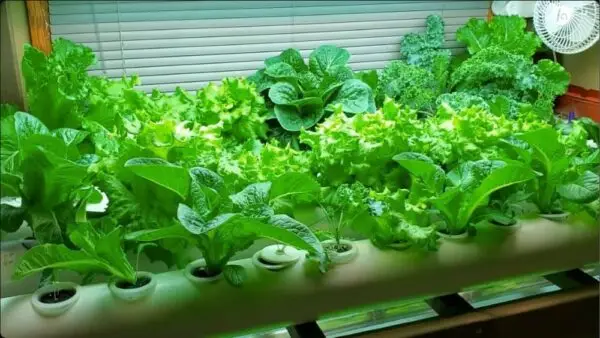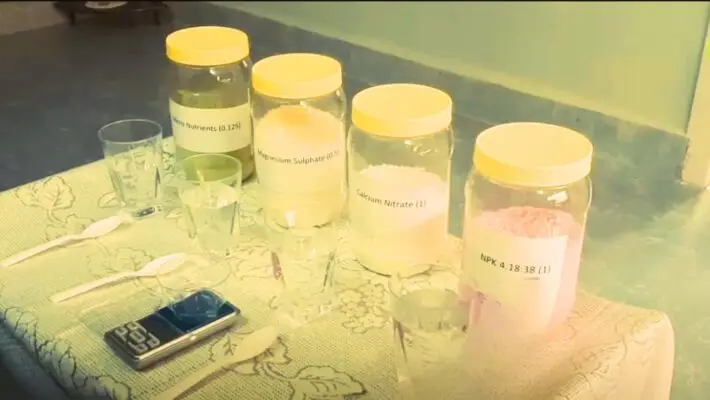5 Hydroponic Nutrient Solution Mistakes That Will Kill Plants
Hydroponics—a nutrient-rich, water-based, soil-less way to grow plants—enormously benefits urban dwellers. A nutrient solution is the cornerstone of this modern farming system. Whether you are a beginner or an expert, you must pay attention to plant nutrition.
Nutrient solutions are the key to a healthy and productive hydroponic garden, but they can cause problems if you’re not careful. This guide will show you “5 Hydroponic Nutrient Solution Mistakes That Kill Plants” and how to avoid them. Learn how to feed your plants and enjoy hydroponic gardening.
Understanding Hydroponic Solutions and Nutrients
Nutrient solutions are essential for water-based gardening. Instead of soil, it provides nutrients to your plants. Here are the key facts you need to know about this:
The Essence of Hydroponic Solutions: Hydroponic nutrient solutions are liquid fertilizers that give plants the nutrients they need to grow. They contain the right chemical compounds of macronutrients (N, P, and K) and micronutrients (Fe, Mn, and Zn) for optimal plant development. These watering solutions are essential for a successful plant life cycle, as they replace soil as the plant’s base nutrient source.
Tailoring to Plant Needs: Nutrient requirements vary from plant to plant. For example, hydroponic tomatoes and strawberries have additional nutrient requirements. You must adjust the solution according to the plant type to grow healthy and productive plants.
Understanding the basics and importance of tailored nutrient solutions can significantly enhance your hydroponic garden’s health and productivity.
Mistake #1: Incorrect Nutrient Ratios in Hydroponic Solution
Hydroponic systems require precise nutrient ratios for different plants. If you get them wrong, you can harm your plants or reduce their yield. You must get it right for the following reasons:
Impact on Plant Health: Nutrient problems or deficiency issues can harm plant development. They occur when some elements, like the NPK ratios, are too high or too low, blocking others’ uptake. For example, excess nitrogen can cause too many leaves and not enough fruit or flowers.
Customizing Nutrient Solutions: As discussed, different plants, like hydroponic tomatoes and strawberries, require different nutrient concentrates. You must customize your DIY or commercial nutrient solutions to grow them well.
You need to do your homework and experiment to avoid this mistake. Monitor how your plant’s functionality reacts to nutrients and make changes. You aim to recreate the optimal natural conditions for each plant in a soil-less system.

Mistake #2: Overlooking pH Levels of Nutrient Solution
Hydroponic solutions’ pH levels are like your home’s thermostat: just as you need the right temperature to feel comfortable, your plants need the right pH level to absorb nutrients effectively. If they are too high or too low, plants cannot absorb nutrients properly, even if you use the most effective nutrient solution. It is called a nutrient lockout, which may harm the growth and health of your plants. To avoid this problem, you must regularly monitor and adjust pH levels, keeping them within the optimal range for your plants.
The Sweet Spot: Aim for a pH range of 5.5 to 6.5, ideal for most hydroponic plants. It ensures perfect nutrient concentrations and is readily absorbed.
Regular Checks: Invest in a quality pH meter. Checking your system’s pH level should be as routine as watering your garden—because, in essence, you are.
Adjusting pH: If the pH level is not in range, use pH up or down solutions to gently nudge it back to the desired range. Remember, minor adjustments can prevent big problems.
Mistake #3: Neglecting Water Quality of Hydroponic Nutrient Solution
Hydroponics requires water quality. If you use contaminated, unbalanced, or neglected water hardness levels, your plants might get infected, or your nutrients and pH levels may be messed up. It can result in poor growth or even death. Here’s what to do:
Water purification: Use purified water to avoid chlorine and other chemicals in tap water. These chemical complexes can harm plant metabolism and disrupt growth. The purified water supply provides a stable environment for plants.
Know Your Water: Test your water. Knowing what’s in it (like water hardness levels) can help you make informed adjustments to your nutrient solution.
Mistake #4: Ignoring Plant-Specific Nutrient Needs
Hydroponic plants’ nutritional requirements vary depending on their species. You can’t use the same nutrient solution for all of them. That would be like giving steak to a vegetarian—it won’t work. It would be best to customize each plant type’s nutrient mix.
Custom Tailoring: To grow healthy and productive plants, research each type’s nutrient requirements and adjust your solution accordingly.
For example, hydroponic tomatoes and hydroponic strawberries have varying nutrient requirements.
Life cycle Adjustments: Different plant life cycles require different nutrients. Seedlings need more nitrogen to grow leaves and stems, while flowering plants need more phosphorus and potassium to produce buds and fruits. Use the appropriate nutrient solutions for each stage to optimize plant growth and yield.

Mistake #5: Failure to Use Organic Hydroponics Nutrients
Hydroponic gardeners must choose proper plant nutrition. The two main options are synthetic and organic. Both have pros and cons, but organic hydro nutrients offer some benefits that synthetic ones don’t.
For example, organic nutrients can improve soil quality, reduce environmental impact, and boost plant immunity.
Understanding Organic Benefits: Organic nutrients come from natural sources and help plants develop faster and healthier in a hydroponic system. They also make fruits and vegetables taste better and support a more diverse ecosystem.
Organic nutrients sustain gardens and reduce environmental impact.
Challenges and Solutions: To switch to organic nutrients, you may need to clean your system more often to avoid clogs. But this extra work pays off in the long run. You will use fewer chemical fertilizers and grow healthier plants with organic nutrients.
Solutions and Preventative Measures
Hydroponic gardening may seem complicated, but it doesn’t have to be. The basics of nutrients, pH levels, and plant care are all you need to know. We’ll show you how to avoid common mistakes and grow a beautiful garden. Here’s how:
Regular System Check-ups: Don’t neglect your system’s pH and nutrient levels. They affect your plants’ health and yield. Check them every week and record the results. By detecting signs early, you can prevent their worsening.
High-Quality Inputs: To grow a healthy garden, choose quality water, nutrients, and seeds. These are the main factors that affect your plants’ functionality.
Don’t skimp on quality for these essentials. Look for water that is clean and free of contaminants, nutrients that are balanced and organic, and seeds that are certified and disease-resistant.
Educate Yourself: Hydroponics is a dynamic field that requires constantly updated knowledge. Read books, visit reliable websites, and join online communities to stay on top of the latest developments and best practices.
Tailor Your Approach: Customize your nutrient solutions and care to each plant’s specific nutrient problems, considering its growth stage and unique requirements.

FAQs
What are the proper nutrients for hydroponic tomatoes and strawberries?
To grow tomatoes, use nutrient solutions with more potassium and calcium. These nutrients help produce fruit. For strawberries, a balanced nutrient solution works best. Increase potassium when they fruit.
Is it necessary to change my hydroponic nutrient solution often?
Changing the whole nutrient solution every two to three weeks is a good rule of thumb. However, it can vary based on the system and plant type.
Are homemade hydroponic nutrient solutions possible?
It is possible to create a cost-effective DIY hydroponic nutrient solution. It would be best to have accurate measurements and plant nutrition knowledge. Follow a reliable recipe and tweak it based on your plants’ feedback.
In hydroponics, what are the signs of nutrient deficiencies?
To avoid nutrient problems, check your plants for symptoms like discoloration—yellow leaves (low nitrogen), brown spots (low potassium), or leaf burn (too many nutrients). Observe the leaves and test the solution regularly to get more information.
How do hydroponic organic nutrients compare to synthetic ones?
Organic nutrients are generally more environmentally friendly, but their concentrations are less predictable. Synthetic nutrients offer precise control but are harsher on the environment.
Conclusion
In this blog, you learned how to manage hydroponic plant nutrition effectively. To avoid common pitfalls and grow healthy plants, remember these key points:
– Check pH levels regularly and adjust as needed.
– Use clean water to filter out contaminants.
– Match nutrient solutions to your plant’s needs and growth stages.
Hydroponics is more than a hobby. It’s a way to create a sustainable and productive food system. Follow these tips and see the difference in your plants.
Call to Action:
Share your hydroponic successes and lessons learned in the comments below. You might help another gardener overcome a problem or improve their productivity. Let’s learn from each other and grow better plants! Happy gardening!

Meet Milan Cole, your urban gardening pro!
Milan Cole, chief content writer at Maven Gardening and an urban gardening expert, is passionate about helping city dwellers cultivate their green thumbs. Armed with extensive horticultural knowledge, Milan provides practical advice for overcoming urban gardens’ challenges, like limited space, water scarcity, and reduced sunlight.
His expertise extends beyond traditional methods, encompassing innovative approaches like hydroponic and aquaponic systems and sustainable gardening practices. Milan skillfully adapts these techniques to urban environments, considering factors like pollution and climate change.
In his clear and concise writing, Milan offers actionable solutions for anyone wanting to bring life to an urban space. He shares valuable insights into growing herbs in tight spaces, maximizing the potential of window boxes, and transforming even the most miniature balconies into thriving green oases.
Milan’s guidance is straightforward and practical, making it ideal for anyone looking to cultivate their own urban garden, regardless of prior experience.
Join Milan Cole on your journey to metropolitan Eden!
